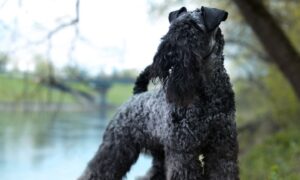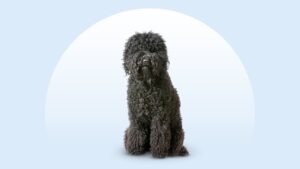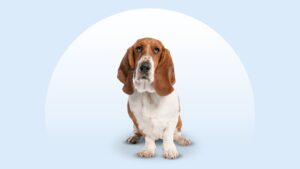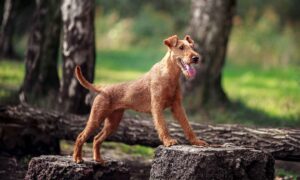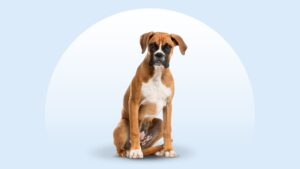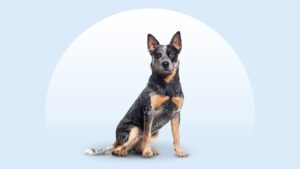Lagotto Romagnolo
Updated December 15, 2025
Lagotto Romagnolo
Updated December 15, 2025
The Lagotto Romagnolo is a feisty pup with a ton of stamina. Because they love to run and play, this renowned truffle-hunter thrives with pet parents who can provide plenty of exercise, lots of grooming and early socialization. Get ready to love this curly-haired cutie with a zest for life!
Feisty, Amiable, Energetic
Male: 29-35 pounds
Female: 24-31 pounds
Male: 17-19 inches
Female: 16-18 inches
15 to 17 years
Brown, Brown Roan, Orange, Orange Roan, White, Sable, Off-White
Looking for a furry friend to add to your big Italian family? Meet the Lagotto Romagnolo, a feisty, playful breed who originated in Italy. These curly-haired cuties may look like teddy bears, but their active, lively personalities will keep you on the move. Lagotti (yes, that’s the plural) are Italian water dogs, so they’ll love to join you on adventures to the beach, lake or river—but the puddles in your backyard will do in a pinch. This joyous breed has a nose for fun and will happily bring you along for the ride.
Lagotto Romagnolo Characteristics
Lagotto Romagnolo Appearance
With their signature wooly coat, bushy beard and pronounced eyebrows, the Lagotto Romagnolo breed is a distinctive-looking medium dog with a powerful build. Their pert, carrot-shaped tails will wag with vigor when time to play. When it comes to coloring, you’ll see everything from white and brown to orange or sable. It’s common for the coat color to fade as these dogs age, but a brown Lagotto Romagnolo puppy may retain that rich, dark color even after they’re full-grown.
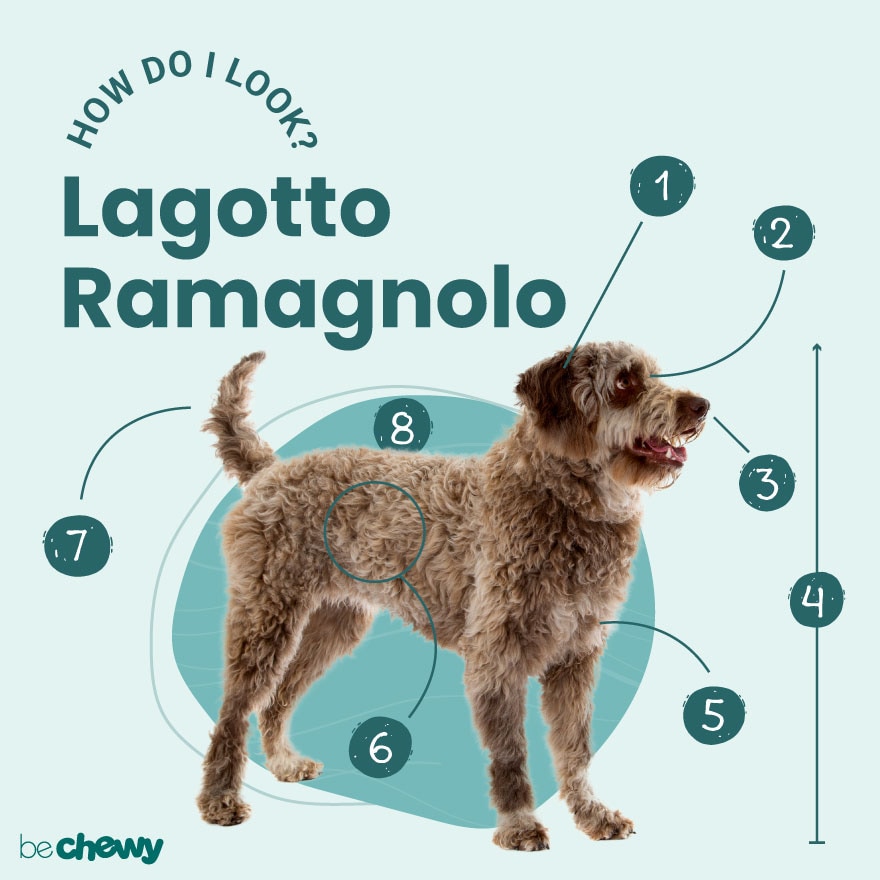
- Ears
The Lagotto dog breed has triangular ears with a rounded tip that fold over to settle around the face.
- Eyes
Lagotti have large, round eyes that are known for looking quite human. Their eye color can vary from dark brown to hazel.
- Nose
Their noses—famous for sniffing out truffles—can be flesh-colored, dark brown or anything in between.
- Coat Length
You'll know a Lagotto Romagnolo by their curly, waterproof double coat, which is no longer than one-and-a-half inches long.
- Coat Color
Lagotti can be dark brown or brown roan (an even mix of white and other colors that don't fade as the dog ages) with tan markings, various shades of white with brown or orange markings, sable, or solid orange or orange roan.
- Tail
The Lagotto Romagnolo dog breed's tail is mid-length and is often described as being shaped like a carrot.
Lagotto Romagnolo Temperament
What can you expect when you share your life with a Lagotto Romagnolo? This renowned truffle-hunter is bright and spirited with a high energy level and zest for life. They get along well with other dogs and kids as long as they have been socialized from a young age.
Lagotti aren’t typically excessive barkers, but they will let you know when the mail arrives or when someone’s at the door, so prepare your guests for a noisy welcome. On the other paw, they can be a little aloof with strangers or get anxious in unfamiliar situations, so start their socialization early by introducing them to new people and places like the park and family gatherings. And teach kids how to interact with dogs. Doing so will help prepare Lagotti for the new situations and unfamiliar faces they will meet on their many adventures with you.
This sensitive dog breed will be very in-tune with their beloved pet parents’ feelings. If you are having an off day, they may well have one too, so take time for a cuddle to cheer you both up. The Lagotto Romagnolo is definitely a pet parent pleaser, so lavish them with love and cuddles and praise them eagerly when they do well in training sessions or dog sports. And you’ll always have company, because this breed is a “velcro dog” type who’ll be stuck to your side day and night.
Bred to be truffle hunters, the Lagotti breed rarely runs out of steam. Think of them as the dog version of the Energizer Bunny.
How to Care for a Lagotto Romagnolo
Lagotti are in the Goldilocks zone of care: not too much and not too little. They need a lot of grooming and exercise and get especially excited about activities that involve water. While some dogs are more attached to humans than others, this is a breed who truly is man’s best friend. Your Lagotto Romagnolo will stay by your side all day long and every chance they get. They don’t enjoy being crated in the daytime, although if crate-trained, they’re usually happy to sleep in a crate at night.
Grooming
Training
Diet
Exercise
Environment
Lagotto Romagnolo Health
The Lagotto Romagnolo can live a long and healthy 15-17 years with the right care, including diet and exercise. Nevertheless, purebred dogs often have a few health issues, and the Lagotto dog is no exception.
- Hip Dysplasia: Hip dysplasia is caused when the hip joint isn’t formed properly and it rubs, causing the dog pain and reduced mobility. This condition is more common in larger dogs, but it can affect the Lagotto breed as well. Because hip dysplasia is hereditary, ask your breeder if they conduct PennHIP or OFA (Orthopedic Foundation for Animals) diagnostic screenings on their breeding dogs. Treatment includes physical therapy, weight control or surgery.
- Juvenile Epilepsy: This recessive and inherited disease can lead to seizures and a short loss of consciousness. Canine juvenile epilepsy typically appears when a Lagotto Romagnolo is very young—usually 5-9 weeks of age—but it often resolves itself when they reach 8-13 weeks. Genetic screening testing is available, so be sure to ask your breeder.
- Lagotto Storage Disease (LSD): LSD is a severe neurodegenerative disease. Symptoms include restlessness, failure to thrive and behavioral changes, such as depression or aggression. This condition typically appears from the ages of 4 months to 4 years. Sadly, there is no treatment available for the disease, but genetic screening testing is available, so be sure to ask your breeder.
- Bladder or Kidney Stones: Lagotti are prone to a condition called hyperuricosuria, which is characterized by elevated uric acid in the urine. This can lead to bladder and kidney stones that may require prescription diet and surgery to treat.
- Cerebellar Abiotrophy: This is an inherited, degenerative condition that causes dogs to have trouble with their balance and walking. Genetic screening testing may be available, and affected dogs should not be bred.
Lagotto Romagnolo History
Michelangelo’s David and the Mona Lisa weren’t the only good things to come out of Renaissance Italy. The Lagotto Romagnolo may not be quite as famous, but they were definitely highly valued in their time—and still are today.
This dog’s origin can be traced to the marshy lagoons around Northern Italy’s Ravenna in the region of Emilia-Romagna, where they recovered waterfowl for hunters. This water retriever is believed to date back to around 1474 A.D. When the area was developed and their bird-hunting days came to an end, the Lagotto Romagnolo’s phenomenal nose was put to use hunting truffles, a rare delicacy even then.
While the Lagotto Romagnolo isn’t the only dog who can hunt truffles, they were first bred for this purpose and are still considered to be the best for the job. In fact, they’re the only purebred dog with this distinction. The Lagotto Romagnolo breed was recognized by the American Kennel Club (AKC) in 2015.
Lagotto Romagnolo dogs generally cost $1,800-$2,500, and you’ll find reputable breeders offering puppies across the United States. For that price, you’ll typically get a dog who has been screened for potential health and behavioral issues and may even come with papers. You might be waiting for some time for a pup, though, as they are rare. Alternately, you could consider adoption through the Lagotto Romangnolo Club of America‘s rescue.
FAQs
How do you pronounce Lagotto Romagnolo?
Are Lagotto Romagnolos hypoallergenic?
How big do Lagotto Romagnolos get?
Do Lagotto Romagnolos bark a lot?
Are Lagotto Romagnolos good family dogs?
What are the most popular names for Lagotto Romagnolos?
Expert input provided by Oregon-based breeder and trainer Carly Luzader with Amico Roma Puppies, and former veterinarian Dr. Heather Rife.
Breed characteristic ratings provided by Dr. Sarah J. Wooten, DVM, CVJ, a veterinarian at Sheep Draw Veterinary Hospital in Greeley, Colorado; dog trainer and behavior consultant Irith Bloom, CPDT-KSA, CBCC-KA, CDBC, owner of The Sophisticated Dog, LLC, in Los Angeles; and certified animal behavior consultant Amy Shojai, CABC, in Sherman, Texas.
The health content was medically reviewed by Chewy vets.

